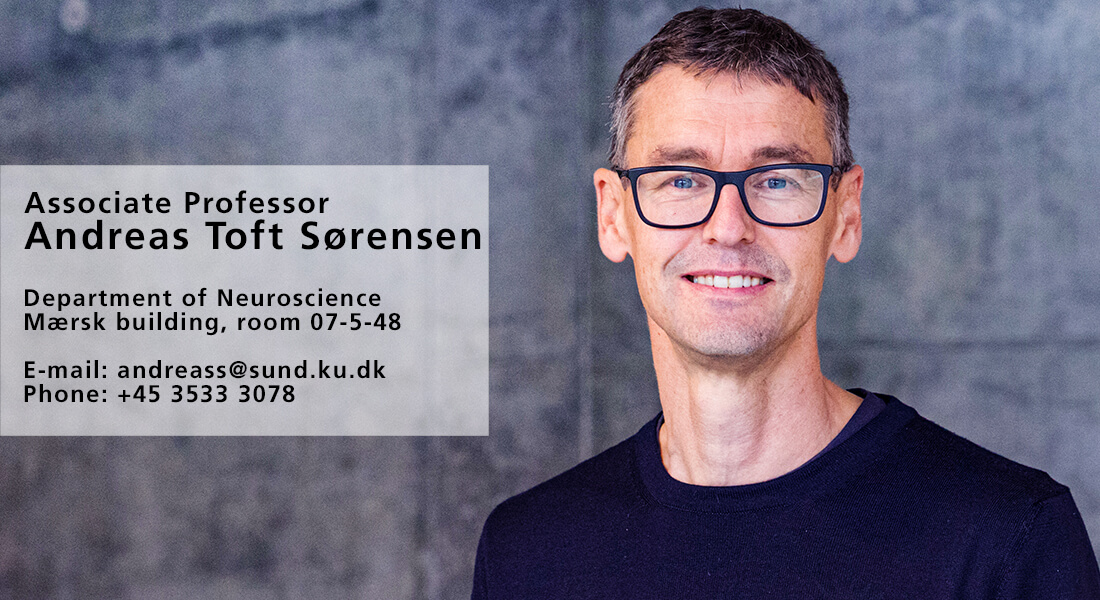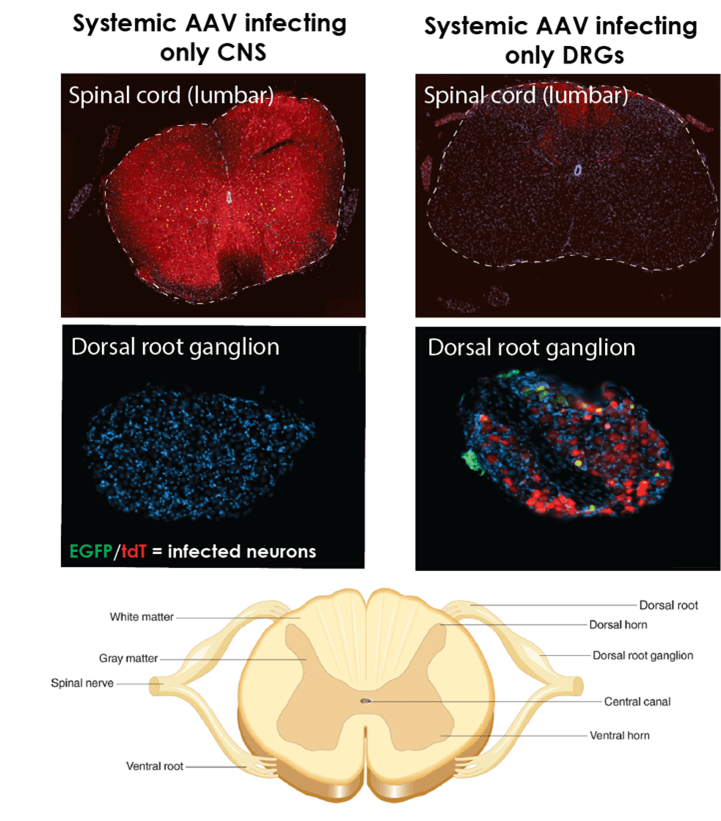Toft Sørensen Lab
The Toft Sørensen lab is exploring, developing and testing new directions of gene therapy by targeting various proteins not regarded as conventional drug targets. The lab is especially focused on exploring what could be new treatment solutions for pain conditions and Alzheimer’s disease, including understanding the mechanisms and probing the neuronal circuits where they act on.

My group invents, and applies, novel viral genetic tools that enable the uncovering of neuronal plasticity mechanisms and animal behavior that otherwise would be impossible to achieve with existing technologies. This also includes exploring how viral gene therapy can be used for potential clinical application to address unmet needs in patients with CNS disorders. Through rational approaches, we engineer DNA that encodes for unconventional recombinant peptides, which upon translation assembly themselves into multimeric peptides or become twisted. By such, the virally expressed peptides can acquire superior and desired properties in terms of higher affinity and target specificity, and capable of interacting with synaptic-associated proteins not normally regarded as traditional drug targets. Because we further harness on the versatile nature of viral vectors that allows for high spatial and/or temporal precision, these genetic tools serve as extremely powerful measures for studying and manipulating brain functions as well as representing clinical relevant solutions for various neurological conditions.
Pathological pain conditions
The lab has a particular interest in understanding pain circuits and treating pathology pain conditions. For this, we apply our viral-genetic technology platforms in various pain models using both wild-type and transgenic mice.

Example of two gene therapy approaches employed in the lab. AAVs packaged with PHP.eB and PHP.s capsids and administrated by a single intravenous injection are selectively infecting CNS and PNS (i.e. dorsal root ganglion), respectively. Both AAVs drive the expression of a dimeric peptide, engineered in the lab, that targets the scaffolding protein PICK1 in neurons. Besides the dimeric peptide, the AAV vectors express Cre-recombinase and EGFP that allow for visualization of infected neurons in red (tdTomato) and green (EGFP) color. Both gene therapy approaches provide complete and sustained pain relief in models of neuropathic pain.
Alzheimer's disease
In this disclosed project having different tracks, we aim to reduce and even reverse maladaptive plasticity and morphological changes occurring at the synaptic level in mouse models of Alzheimer’s disease.
To follow...
PROFESSIONAL APPOINTMENTS
From 2021: Group leader – Associate Professor, University of Copenhagen, Denmark
2014-2021: Postdoc/Assistant/Associate Professor, University of Copenhagen, Gether laboratory
2011-2015: Postdoc, MIT, USA, Department of Brain and Cognitive Sciences, Yingxi Lin laboratory
2008-2011: Postdoc, Lund University, Sweden, Experimental Epilepsy Group, Merab Kokaia laboratory
2004-2008: PhD student, Lund University, Sweden, Restorative Neurology, Olle Lindvall & Merab Kokaia laboratory
EDUCATION
2008 PhD degree in Experimental Neurology, Department of Clinical Sciences, Lund University Hospital, Sweden
2004 Master’s degree in Human Biology, University of Copenhagen, Denmark
2001 Bachelor’s degree in Exercise and Sport Sciences, University of Copenhagen, Denmark
Molecular techniques: PCR, WB, FPLC, FP, Co-IP, Bio-ID, multiple cloning techniques, and sequencing.
Engineering of recombinant peptide: Design of novel recombinant peptides for adapted properties and ready for AAV gene therapy.
AAV production: In-house production of AAV ready for in vitro or in vivo application. Multiple serotypes available, including AAVs for non-invasive systemic administration.
Viral techniques: Combines a variety of viral techniques for gaining both spatial and temporal control of transgene expression (recombinase systems, Tet-OFF system, AAV, CAV2, engineered promoters).
Animal surgery: stereotactic surgery, multiple AAV administration routes, lesions to the nervous system.
Tissue processing and imaging: ICC, IHC, light-sheet, epifluorescence and confocal microscopy, biosensors (in vivo).
Animals models and testing: WT and transgenic mice, pain models (evoked and spontaneous pain), open field, rotarod, DigiGate, memory models (Barnes maze, Morris water maze, novel object recognition, conditioned fear conditioning), conditioned place preference, etc.
Andreas T. Sørensen, Kenneth L. Madsen, Nikolaj R. Christensen, Kristian Strømgaard. International filling: PCT/EP2021/055647 entitled ”Viral multimeric peptide constructs for targeting PDZ domains” filled to European Patent Office (EPO), 2020
Andreas T. Sørensen, Kenneth L. Madsen, Nikolaj R. Christensen, Kristian Strømgaard. International application: WO 2020/083916 entitled “Virally expressed inhibitors of PDZ domains, such as PICK1, and uses thereof”
Lab members
| Name | Title | Job responsibilities | Image |
|---|---|---|---|
| Search in Name | Search in Title | Search in Job responsibilities | |
| Carolyn Marie Goddard | PhD Fellow | NAD |
|
| Gith Noes-Holt | Guest Researcher | Zyneyr |
|
| Jeppe Theisen Pedersen | Master-Student | Toft Sørensen Lab |
|
| Julia Alicja Szczygiel | PhD Fellow | Toft Sørensen Lab |
|
| Lucija Pinteric | Master-Student | Toft Sørensen Lab |
|
| Marco Benjamin Khelfa Kowenicki | Guest Researcher | Zyneyro |
|
| Pernille Hammer Jeppesen | Master-Student | Toft Sørensen Lab |
|
| Raquel Comaposada Baro | Postdoc | Toft Sørensen Lab |
|
| Siyue Sun | Master-Student | Toft Sørensen Lab |
|
| Sofie Pilt Boesgaard | Laboratory Assistant | Zyneyro |
|
| Zhuangnan Zuo | PhD Fellow | Toft Sørensen Lab |
|
